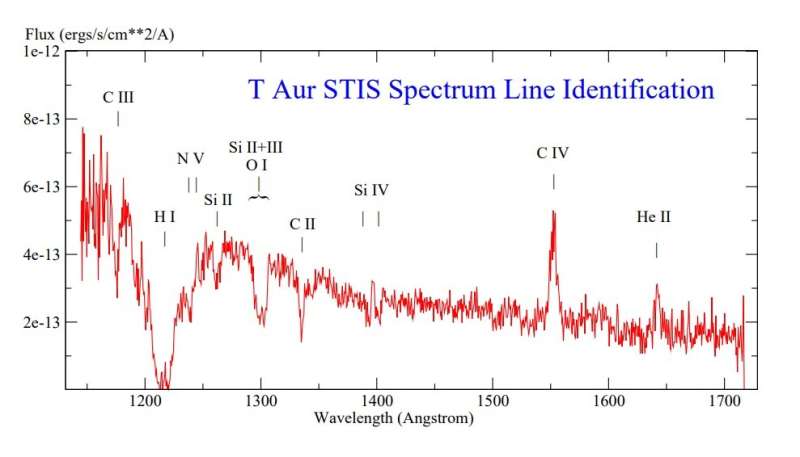The HST/STIS spectrum of the Nova T Aurigae 1891 is shown with line identification. Credit: Larsen et al., 2022.
Using the Hubble Space Telescope (HST), astronomers from Villanova University have analyzed spectroscopic observations of a nearby old nova known as T Aurigae. Results of this study, published March 29 on the arXiv pre-print server, deliver more insights into the properties of this object.
A nova is a star experiencing a sudden increase in brightness and then slowly returning to its original state, a process that could last many months. Such an outburst is the result of the accretion process in a close binary system containing a white dwarf (WD) and its companion.
Cataclysmic variables (CVs) are binary star systems consisting of a WD primary that is accreting matter from a normal star companion. They irregularly increase in brightness by a large factor, then drop back down to a quiescent state.
T Aurigae is a CV composed of a WD in a compact binary with a main sequence-like donor star. It underwent a classical nova explosion in 1891 in the constellation Auriga, which made it the first nova to be observed spectroscopically. The distance to T Aurigae is estimated to be between 2,650 and 2,840 light years.
Recently, a team of astronomers led by Villanova University's Conor Larsen has investigated T Aurigae using the data from Hubble's Space Telescope Imaging Spectrograph (STIS).
"We retrieved the Hubble Space Telescope Imaging Spectrograph data from the MAST archive that had been obtained during a quiescent interval on March 7, 2003," the researchers wrote in the paper.
By analyzing the spectrum of T Aurigae, Larsen's team found that it is an accretion disk-dominated old nova. This hypothesis was further confirmed by the flickering present in the light curve and model fitting performed by the scientists. It was noted that the accretion light from the disk would fully account for the observed luminosity of this nova.
The results show that the white dwarf in T Aurigae has a mass of about 0.7 solar masses and a mass transfer rate is at a level of around 0.000000018 solar masses per year. The distance to the nova was determined to be 2,738 light years.
The inclination of the system was measured to be approximately 60 degrees. The astronomers assume that in order to have such inclination, part of the accretion disk, perhaps the hot spot, must be eclipsing.
The spectroscopic study also identified deep absorption lines of metals in the spectrum of T Aurigae. The authors of the paper noted that they cannot form in the disk and are likely forming in material above the disk in circumbinary material. The other plausible scenario is that they formed in the shell ejected by the 1891 explosion. Further studies, especially far-ultraviolet spectroscopic observations of this system, are required in order to confirm any of these hypotheses.
More information: Conor Larsen, Patrick Godon, Edward Sion, Hubble Space Telescope STIS Spectroscopy of Nova T Aurigae 1891. arXiv:2203.15626v1 [astro-ph.SR], arxiv.org/abs/2203.15626
© 2022 Science X Network
























